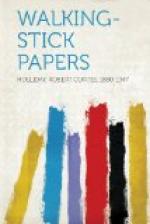In the more complex social organisms of Europe the custom of lifting the hat to other men whom one thus acknowledges as superiors is much more prevalent than in our democratic country. Though in America we remove our hats in elevators upon the entrance of ladies, a practice which is not followed in England. It was Mrs. Nickleby who indicated the extreme politeness of the noble gentlemen who showed her to her carriage by the celebrated remark that they took their hats “completely off.” We express great joy by casting our hats into the air. If I wish to show my contempt for you I will wear my hat in your house; if I wish you to clear out of my house I say: “Here’s your hat”; if I am moved to admiration for you I say: “I take off my hat to you.” I greatly enjoy seeing you run after your hat in the street, because you are thereby made excessively ridiculous. The comic Irishman of the vaudeville stage makes his character unmistakable to all by carrying his clay pipe in his hat band. The English painter, Thomas Gainsborough, gave his name to a hat. The seasoned newspaper man displays his cynical nature and complete disillusionment by wearing his hat at his desk. A hat worn tilted well back on the head indicates an open nature and a hail-fellow-well-met disposition; while a hat decidedly tilted over one eye is the sign of a hard character, and one not to be trifled with. In the literature of alcoholism it is written that a common hallucination of the inebriate is that a voice cries after him: “Where did you get that white hat?” Upon assuming office the cardinal is said to “take the hat.” When a man is conspicuously active in American political life “his hat is in the ring.” Whistler topped off his press-agent eccentricity with a funny hat. The most idiosyncratic hat at present in America is that which decorates the peak of Mr. Bliss Carman. The hat-stands in our swagger hotels make a great deal of money; I know a gentleman who affirmed that a hat which had originally cost him three dollars had cost him eighteen dollars to be got back from hat-checking stands. Cheap people evade the hat-boy.




